Hacienda Zuleta – Where the Condors Are
Hacienda is one of those words that just slips off your tongue and evokes images of bygone romance in colonial Latin America. I first fell in love with it as a kid watching the great Guy Williams as Zorro in the series set in pre-independence from Spain southern California. His father owned a large hacienda and brought his son back from Spain to fight injustices imposed upon the poor people by the ‘authorities’. Thus my first impression of hacienda owners and haciendas in general was that they were good things. Later in life I learned that the opposite was the case. Haciendas were for the most part instruments for squeezing as much out of the land as possible at the expense of the common people, usually Indigenous or Mestizo. If Zorro had been reality based it would have been the hacienda owners using the authorities to support their oppressive regime, not the other way around. , there are exceptions to the rule and in those post from my recent trip to Ecuador with Adventures Abroad we will visit Hacienda Zuleta where the Lasso family has for over a century been a benevolent force for both the local people and endangered Andean wildlife. It should be an eye-opening experience.
Our journey today started in the historic part of Quito with a guided walk led by our guide Alfredo Meneses after which we departed the city heading north on the Avenue of the Volcanoes towards the city of Cayambe and then a little further to the Hacienda Zuleta. Once outside the city which seems to go forever, it should take about two hours to get there. On the original itinerary we were to stop at the Mitad del Mundo monument which sits atop the equator just north of the city and claims to be the most visited tourist site in Ecuador. However, we are in a race against time. Every November up to 800,000 people make a pilgrimage on foot from Quito to the small town of El Quinche to venerate a statue of the Virgin Mary that is claimed to have miraculous powers. That pilgrimage is about to get underway and when it does the road will be closed. We pass hundreds of pop up stands on the route to El Quinche, all catering to the needs of the pilgrims who will begin a walk that begins this night. Alfredo promises that when we recross the equator on the way back to Quito we will stop at a smaller monument for photos, avoiding the crowds that usually throng the Mitad del Mundo, so missing it today is not such a big deal.
The area immediately north of Quito is a dry zone, but soon gives way to the lush Cayambe valley where 18,996 foot (5789 metre) Cayambe volcano dominates the landscape. Since we are literally at the equator altitudes that in latitudes further north or south would be treeless and snow covered are here still covered in forests and at all but the highest altitudes, open grassland. I had always pictured the Andes as we see them in photos, mostly from Chile, as similar to the North American rockies, but in Ecuador that’s not the case. The snow cover here doesn’t begin until around 15,000 feet.
We do manage to beat the closure of the highway, not that I thought we wouldn’t, and arrive at Hacienda Zuleta in the late afternoon.
History of Hacienda Zuleta
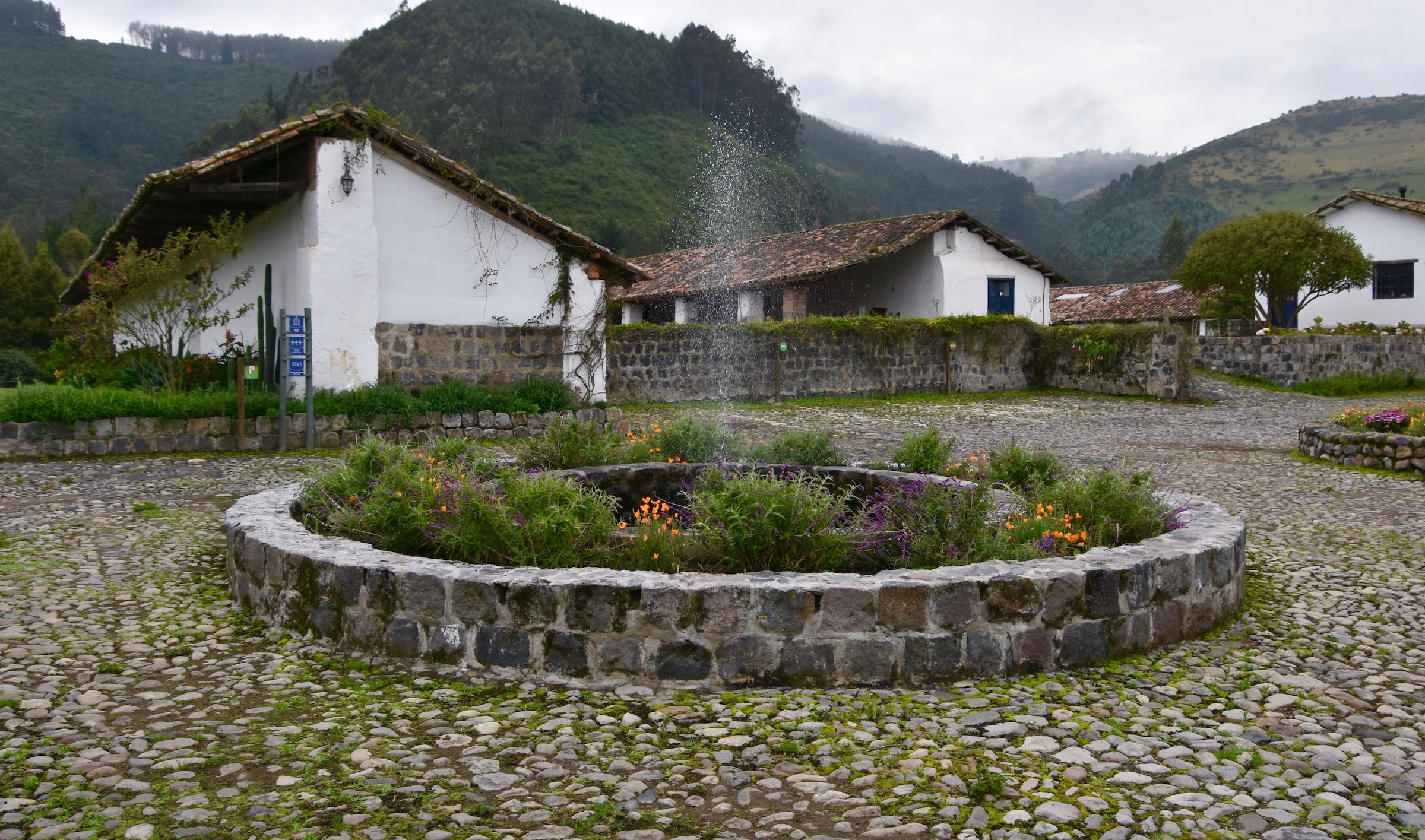
Not surprisingly the history of Hacienda Zuleta did not start with the Spanish conquest or even the Incan one that preceded it. There are signs of occupation found on the 4,000 acres that comprise the totality of the hacienda’s lands that date back to 1,750 BCE. However, the most prominent pre-Incan people were the Caranqui, a loose confederation of Indigenous people who occupied an area from north of modern day Quito all the way up to Colombia. Between 1,200 and 1,500 the Caranqui built hundreds of raised mounds called tolas that served platforms for ceremonies, burials and the homes of local chiefdoms, not entirely dissimilar to many other pre-Columbian peoples throughout much of the Western Hemisphere. Then came the Incas, who after protracted battles including the ultimate one at Lake Yahuarcocha where an estimated 50,000 Caranqui were massacred, subjugated and ruled the people of the northern Ecuadorean Andes.
On our visit to Hacienda Zuleta we saw quite a number of these Caranqui mounds as we travelled up the valley to the Condor Centre, almost none of which have been excavated or examined by archaeologists. Who knows what might lie within them? I would have loved the chance to walk among them to try to feel the vibes one often gets visiting ancient ruins, particularly if they are not major tourist destinations as these most definitely are not. Unfortunately, the itinerary gave us only the one day at Hacienda Zuleta and it was not possible, but if any reader ever gets there on your own the place deserves at least two nights to take in all it has to offer.
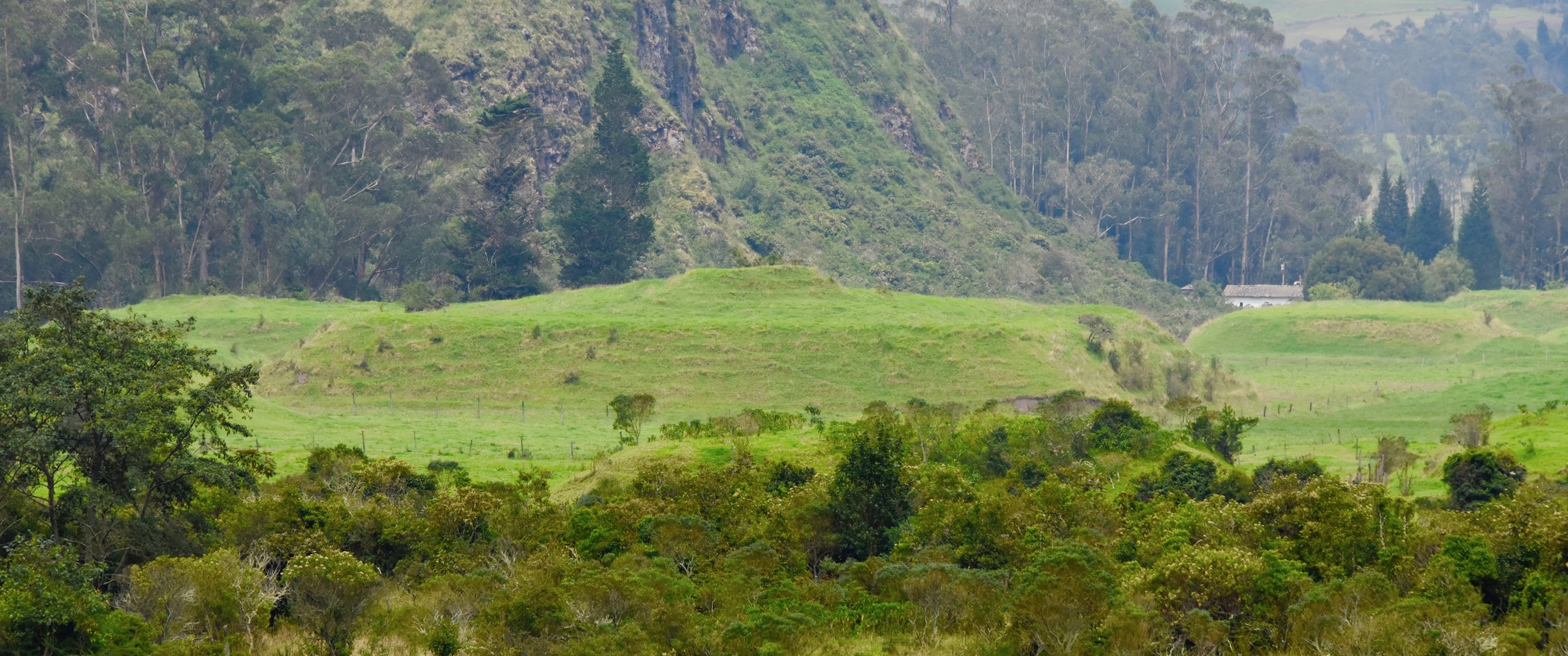
As we know, the Incas did not have long to enjoy their overlordship of the Caranqui and other peoples they had conquered and subdued. The Spanish arrived in Ecuador in 1531 and in rapid succession decimated the Incas and established their own system of rural land ownership, the hacienda system. Under this system Spanish noblemen or church leaders petitioned the Spanish crown for huge grants of land, mostly in the fertile Andean highlands. The successful petitioners operated them as agricultural enterprises using the labour of Indigenous and Mestizo people in a manner not that different from European serfdom.
Some of the buildings at Hacienda Zuleta date from the late 1600’s when the Jesuits were granted ownership. However over time, they fell out of favour with the authorities and in 1713 one Canon Gabriel Zuleta obtained ownership of the hacienda, one of seventeen he amassed during his lifetime. After his death the Posse family owned it until 1898 when it was purchased by José María Lasso and it has remained in the ownership of that family until the present day. Along the way two president’s of Ecuador, Leonidas Plaza and Galo Plaza have called the place home. The latter was the first truly democratic leader of Ecuador who instituted many reforms, among them one that led to the abolition of the hacienda system. While Hacienda Zuleta is today a fraction of its original size, much of the original land having been returned to the descendants of the people who worked it for centuries, it is still a major agricultural operation as well as being a luxury resort and a wildlife conservation centre. The progressive views of the Lasso/Plaza family are leading the way in showing how a modern day hacienda can be run in a sustainable and non-repressive manner while at the same time show casing the grandeur and romance of the hacienda that I first felt on watching Zorro many decades ago.
Exploring Hacienda Zuleta
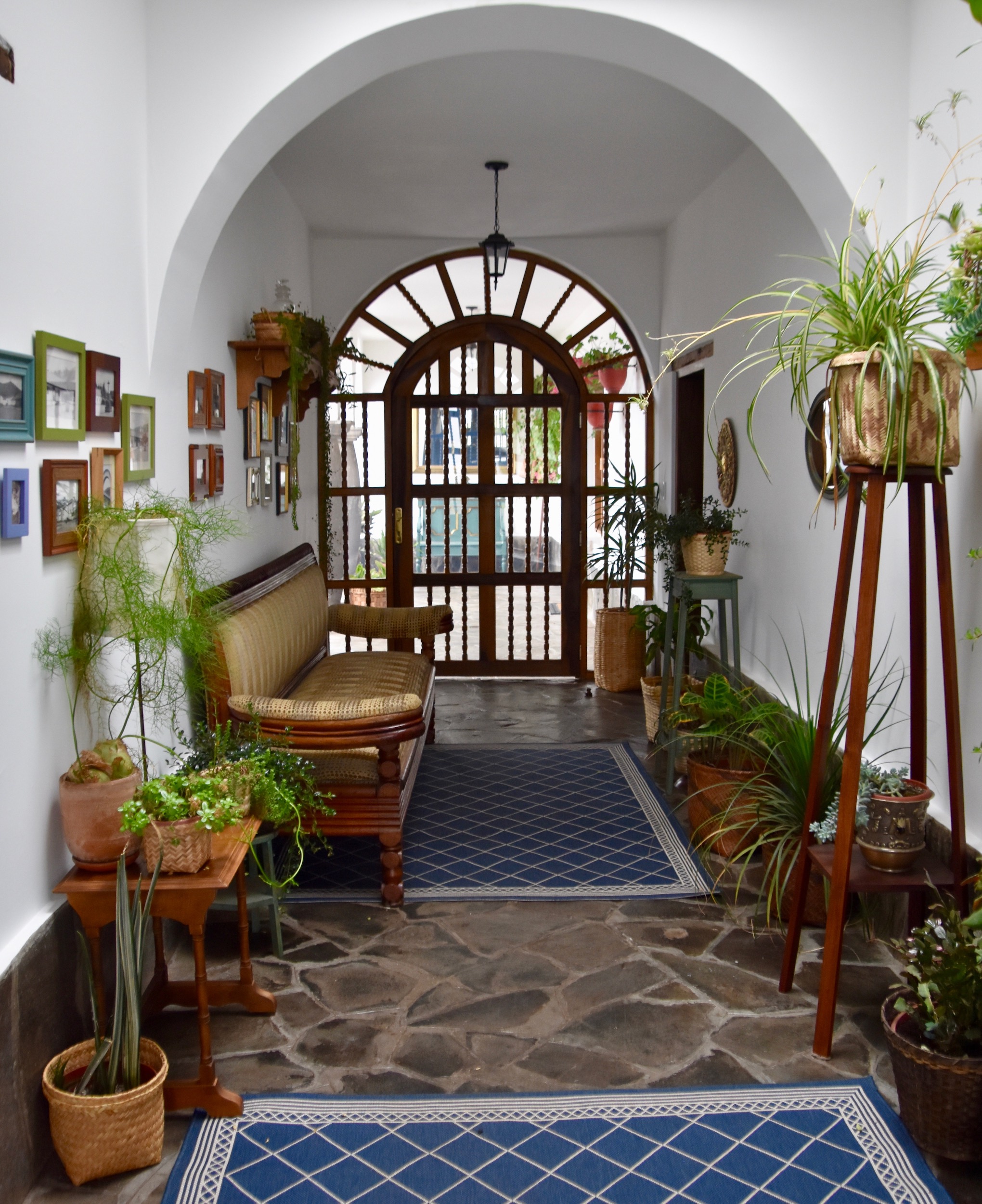
After pulling into the interior courtyard of Hacienda Zuleta our group was offered a welcome drink and given a rundown on the history of the property as well as the many activities that the resort offers.
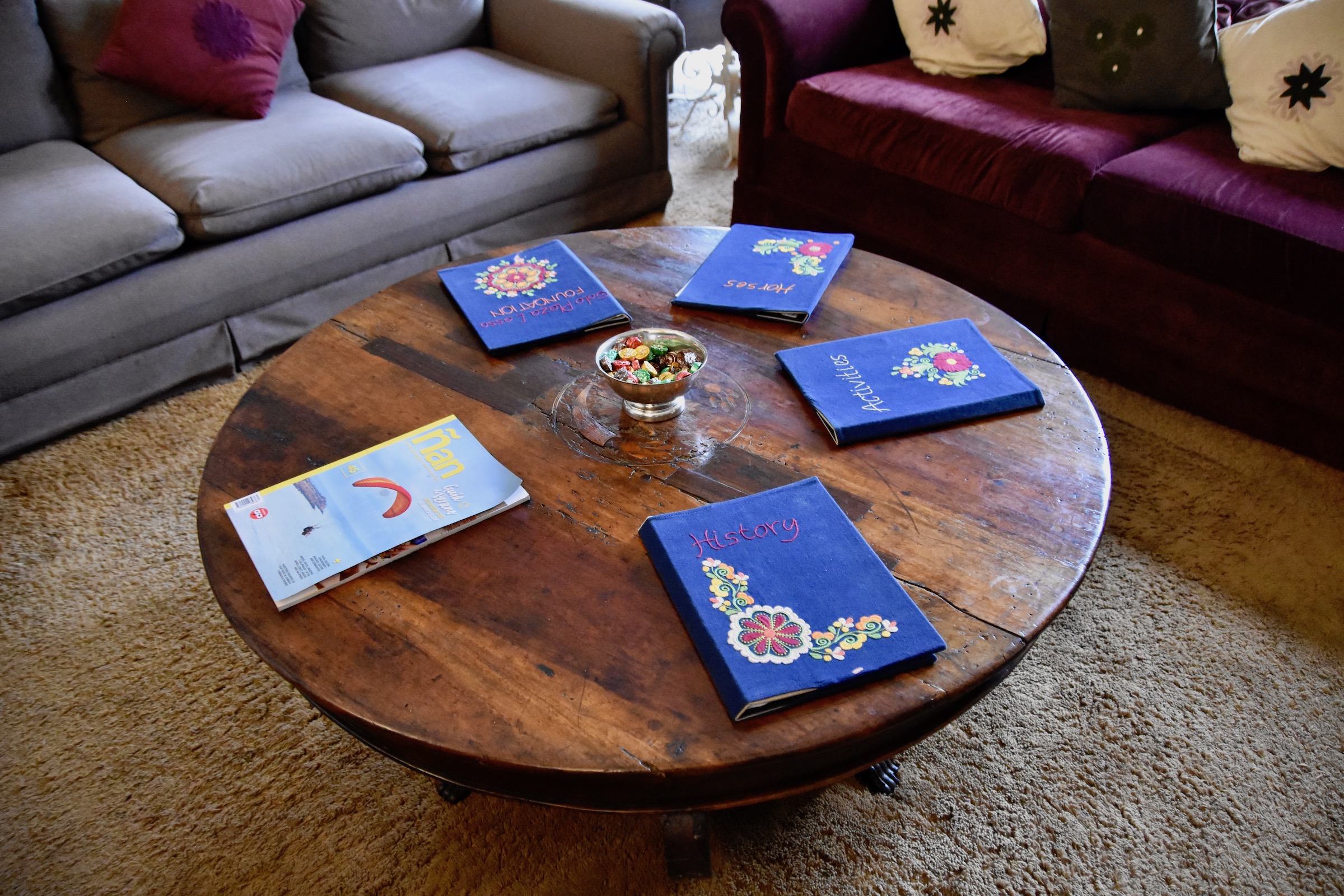
After that we were escorted to our rooms to freshen up before dinner or free to just explore the place inside and out. This is the exterior of our room which was typical of what most couples received. This is as about a welcoming entrance as I can conceive of.
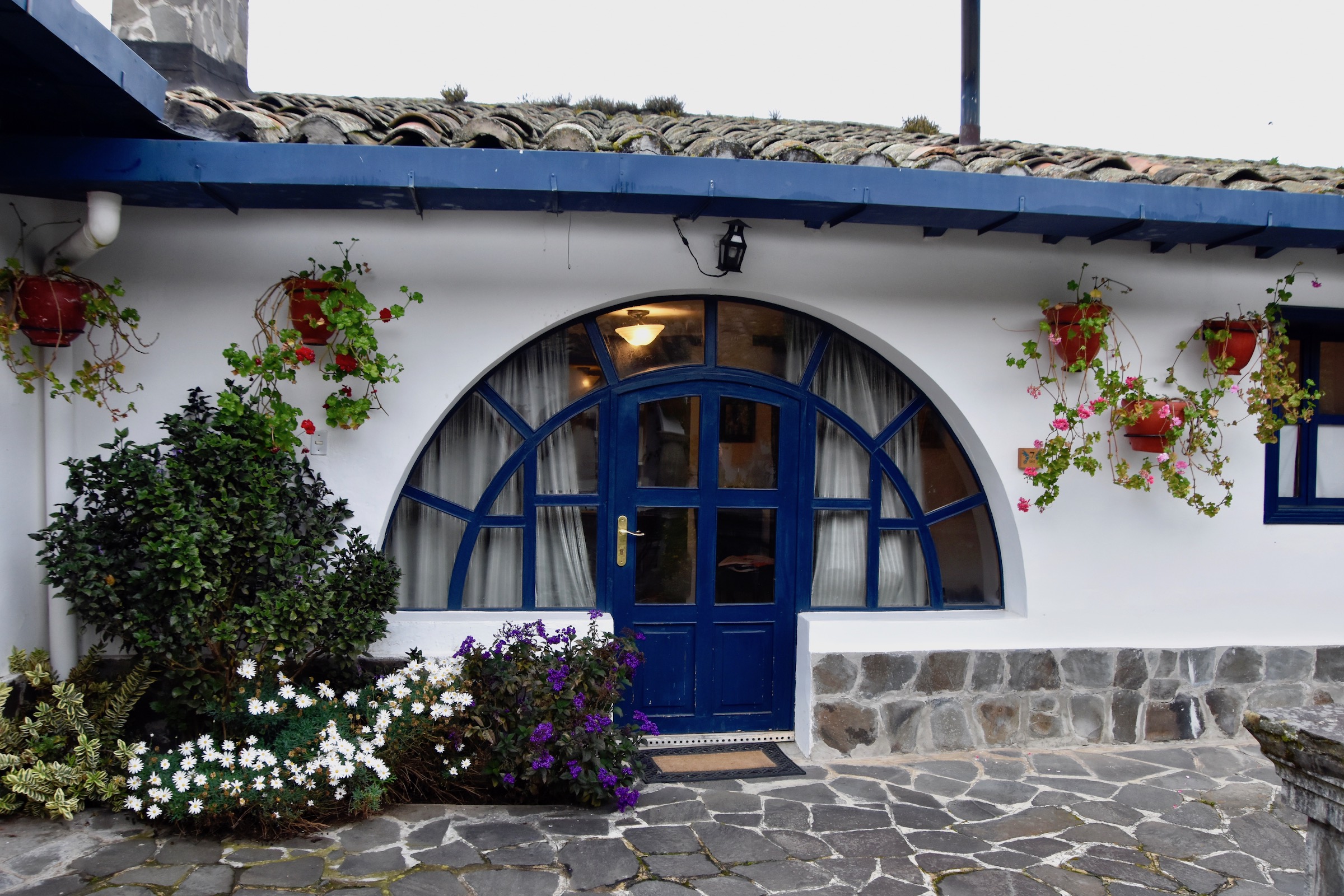
The interior, while not overly spacious, was very homey and comfortable with a really nice touch being this wood burning fireplace. The Hacienda Zuleta is located at an altitude of over 9,600 feet (2,926 metres) and even at the equator it can get chilly at night. When we returned from dinner the fire was burning brightly and the room had a toastiness to it that guaranteed a good night’s sleep.
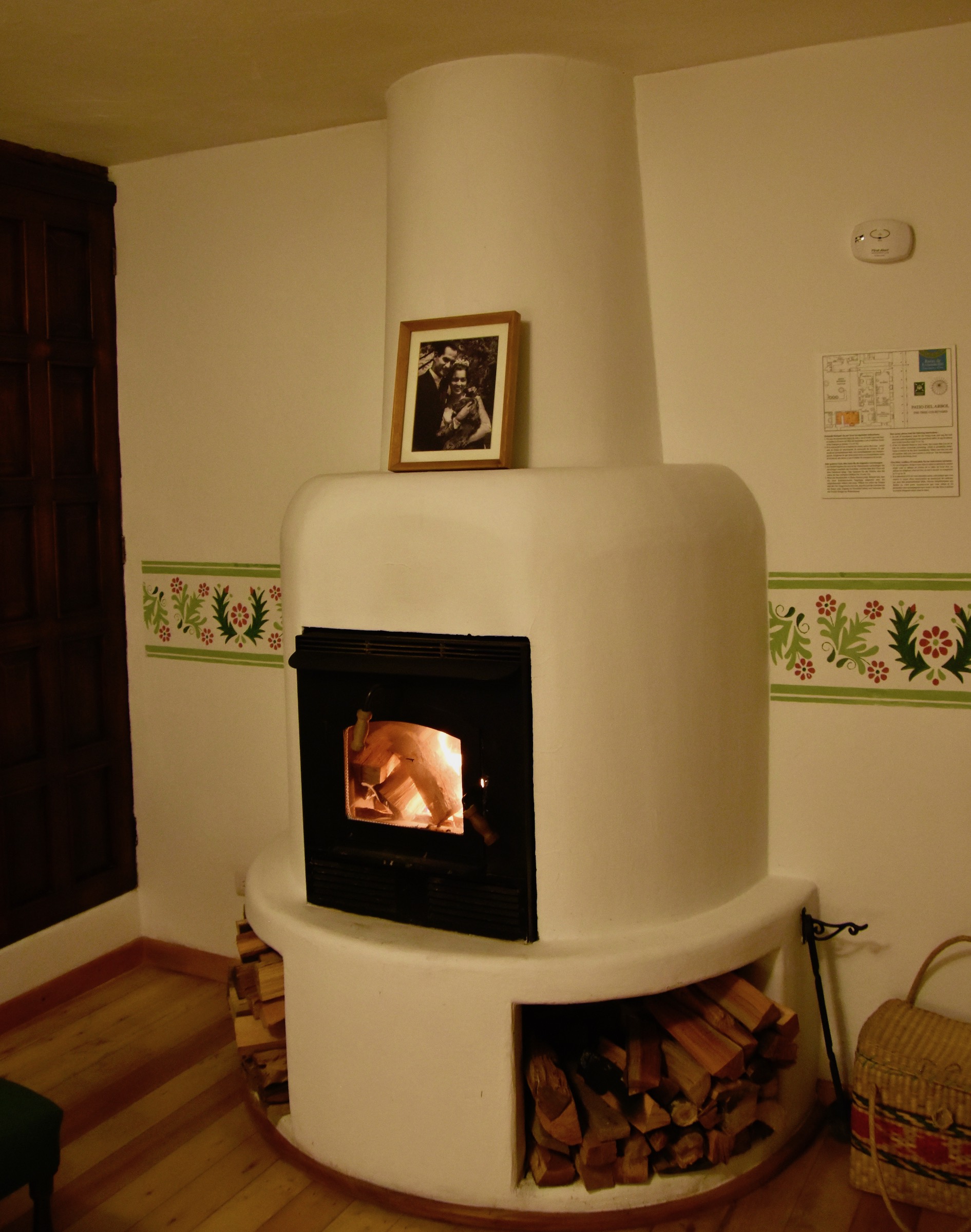
However, there is a lot more to see before packing it in.
The Hacienda Zuleta is still a family home as well as being a resort and that was very much in evidence as I walked from room to room. There were family pictures and mementoes in every room. The expression ‘me casa es su casa’ definitely came to mind as I walked from room to room.
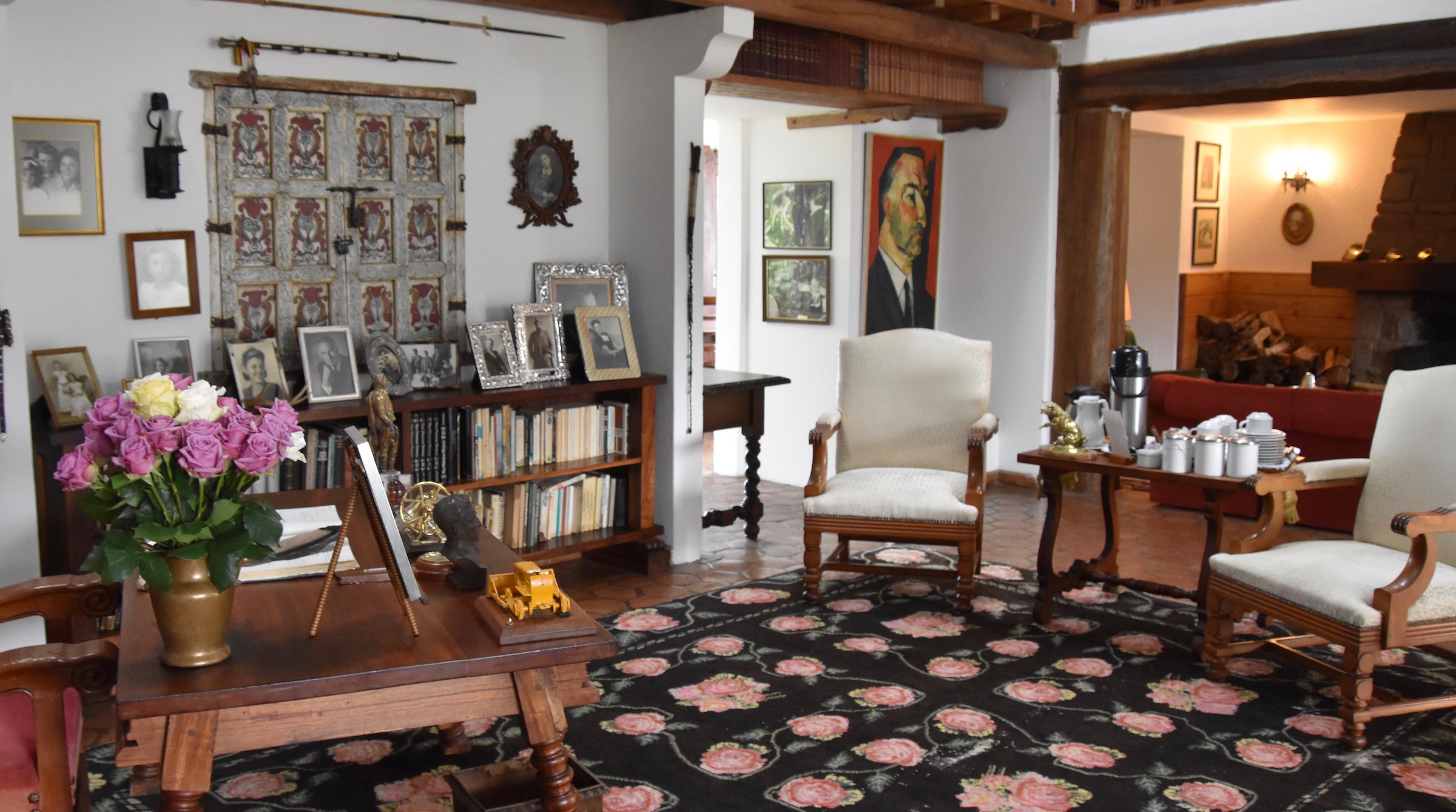
Perhaps the most impressive room at Hacienda Zuleta is the library with its wooden beams that are hundreds of years old.
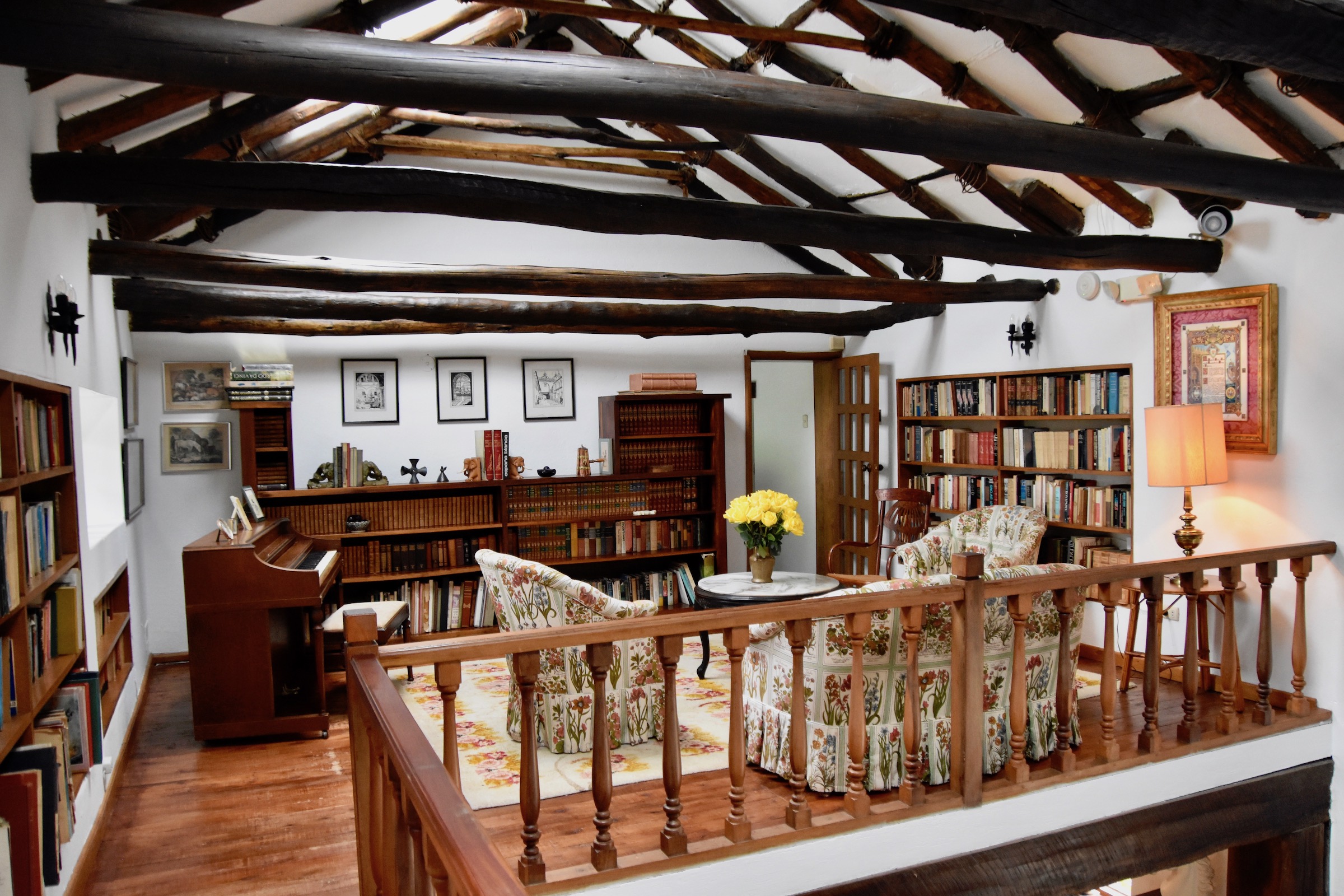
The most interesting of many curios found throughout the hacienda was this beautifully inlaid strongbox with many different compartments for storing valuables. These are usually found in churches where parishioners could apply to rent one compartment of these strongboxes much as we do today at a bank with safety deposit boxes. Instead of remembering your number you remember your animal.
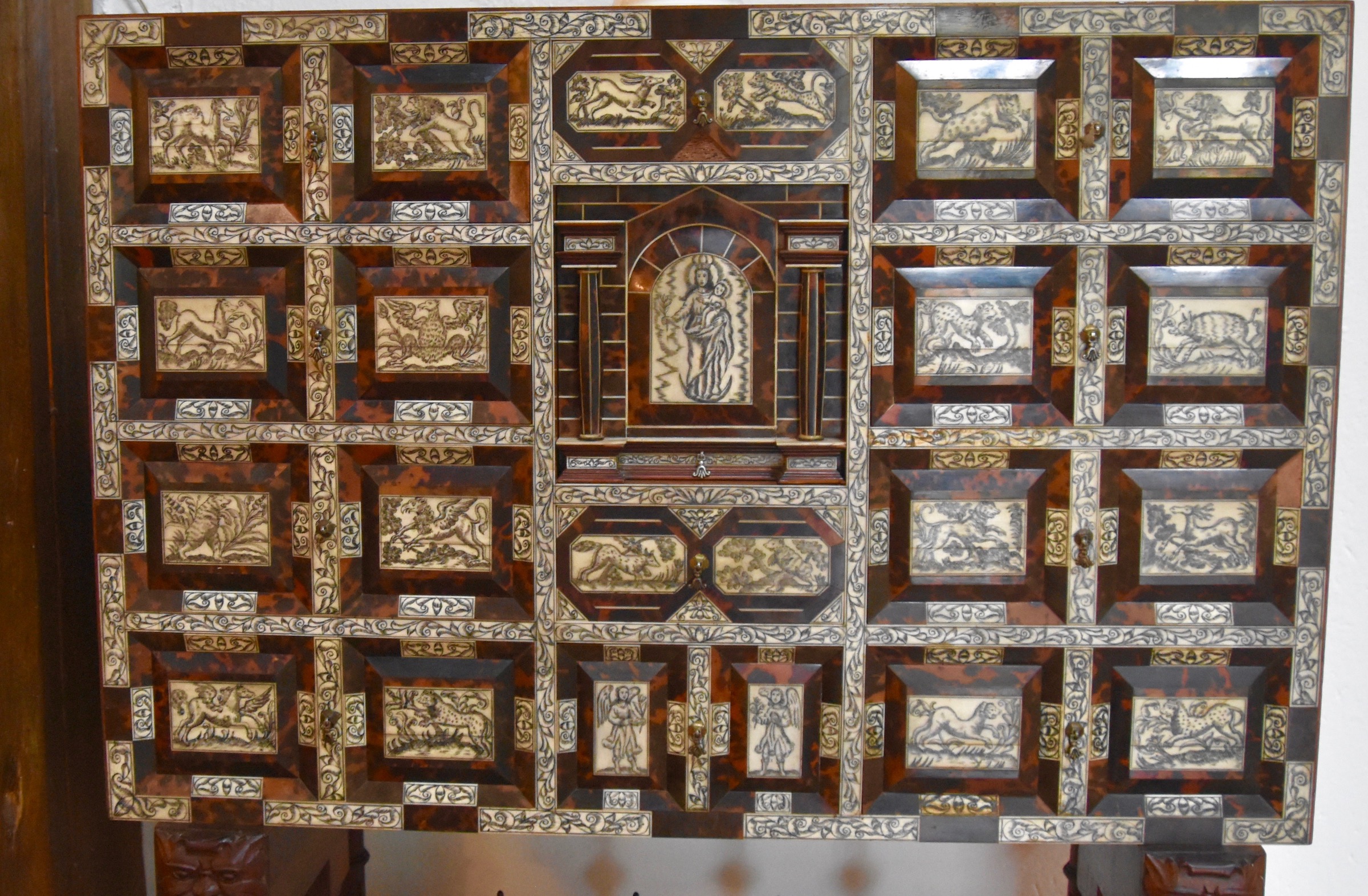
The exterior of Hacienda Zuleta is definitely worth exploring as well with extensive gardens, a cheese factory, stables and more. This is a planting of many types of cacti and succulents.
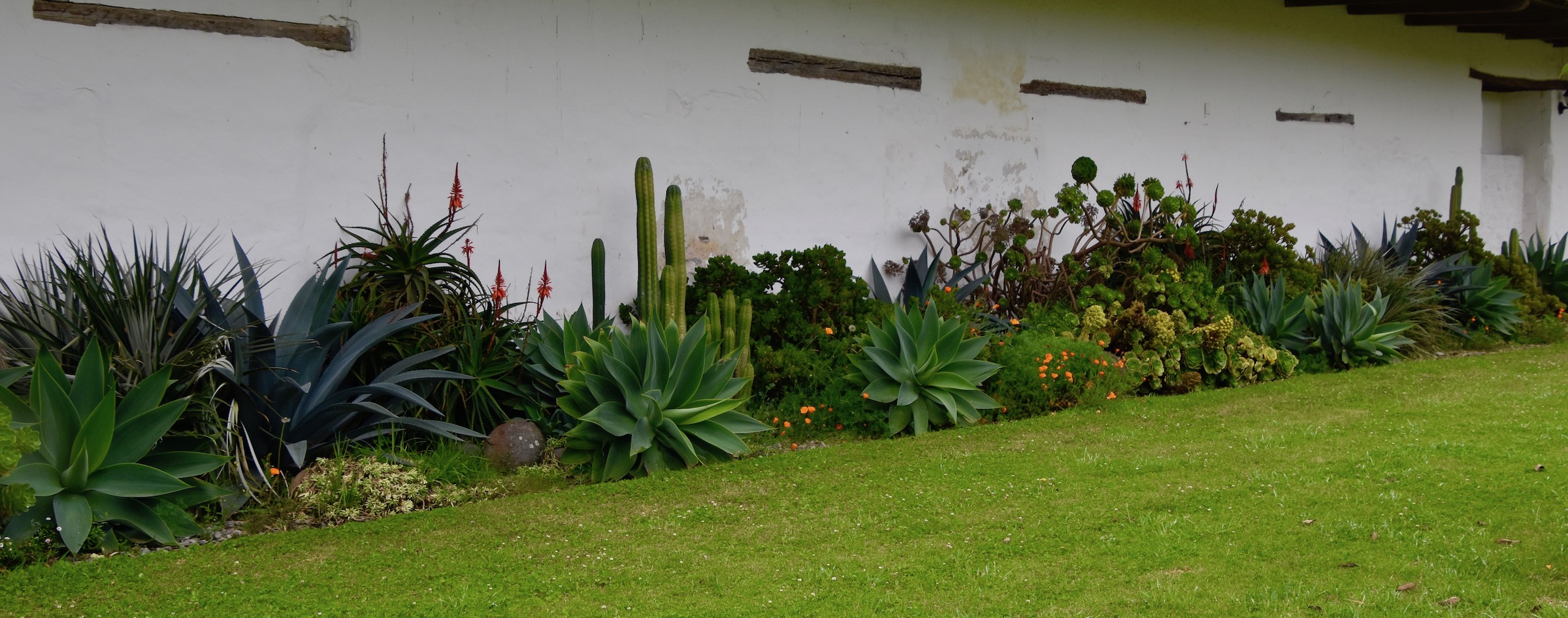
This is the herb garden.
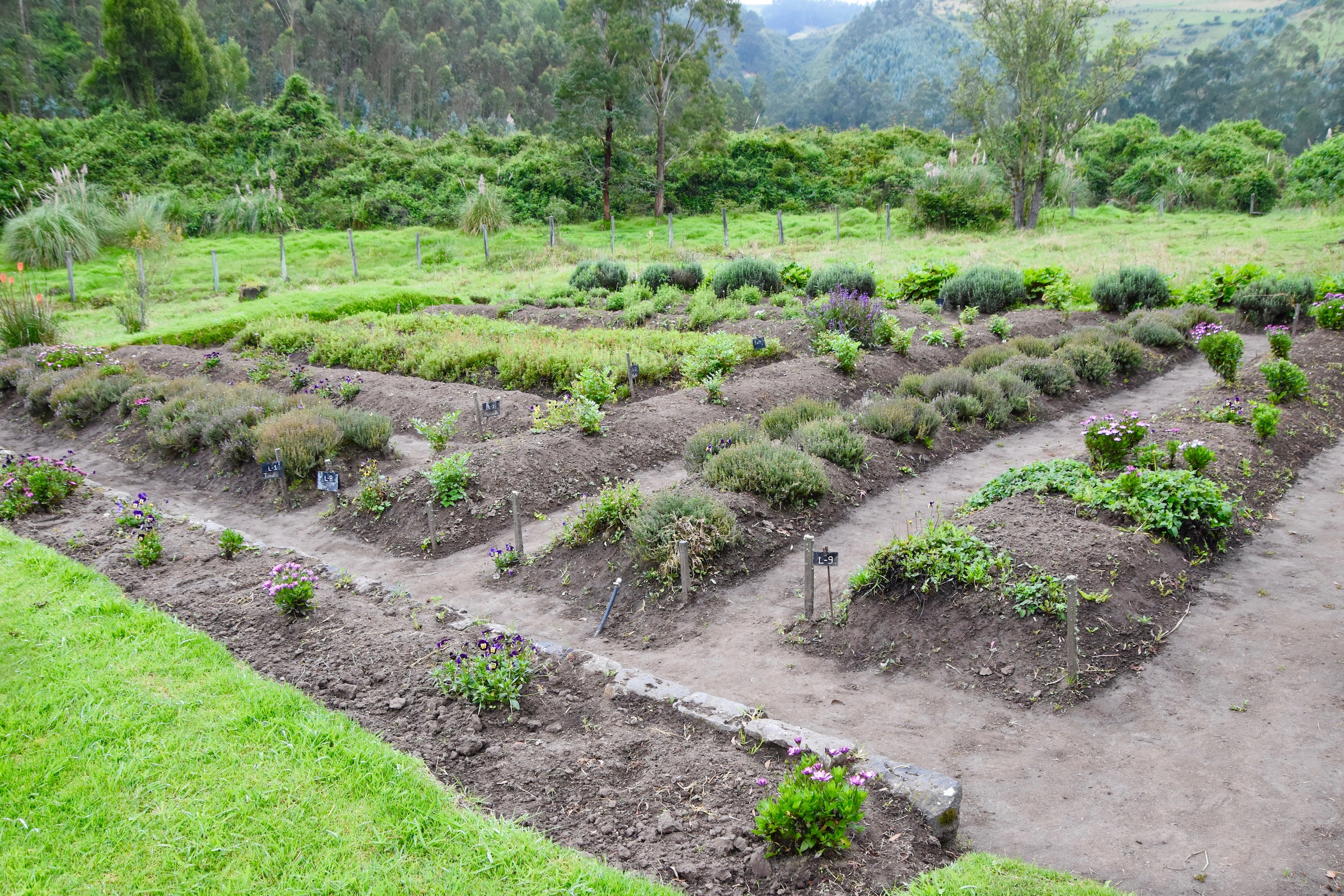
Speaking of herbs, it was time for a meal in the impressive dining rooms where one table could accommodate our entire group. This is from breakfast the next morning.
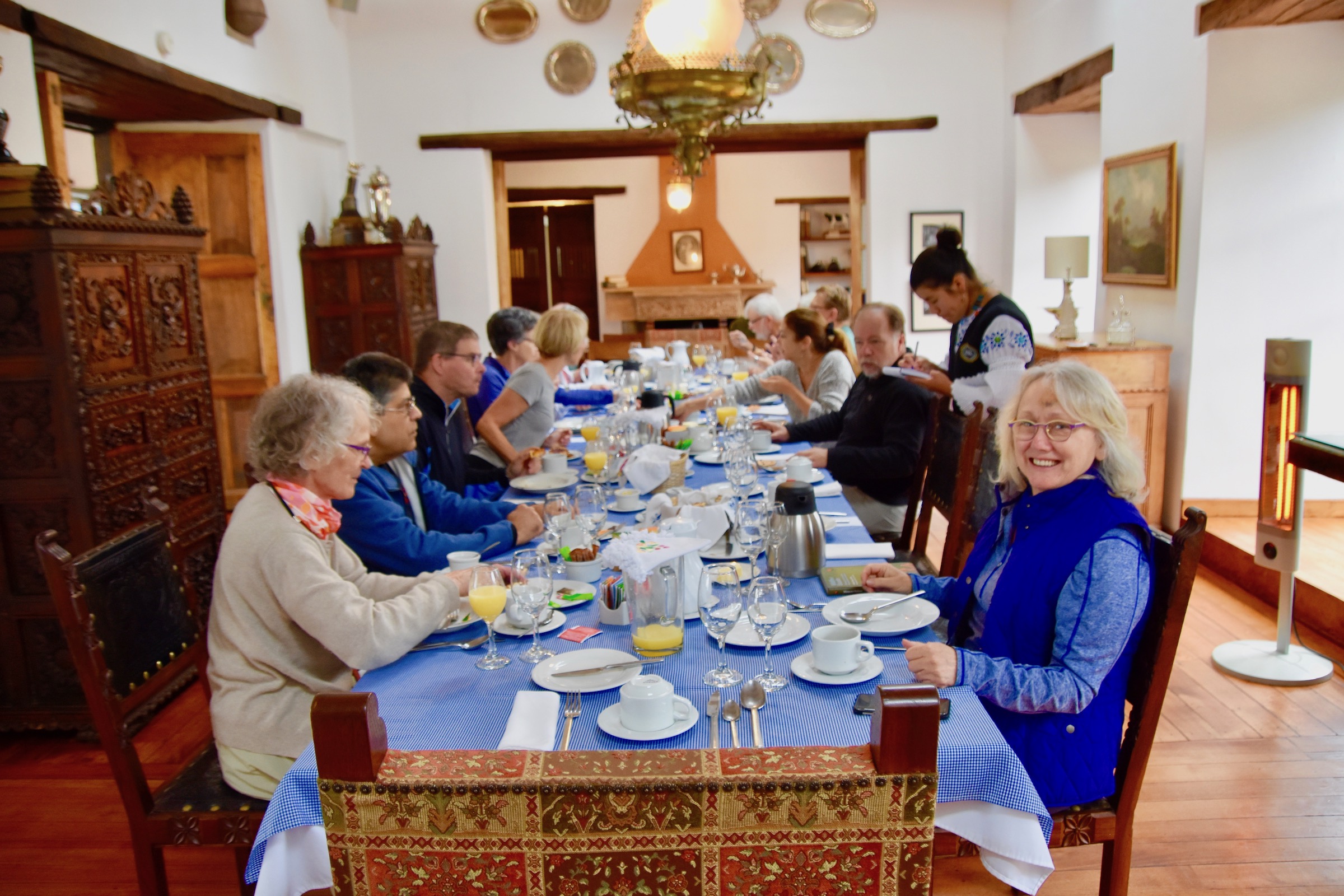
The Condor Huasi Project
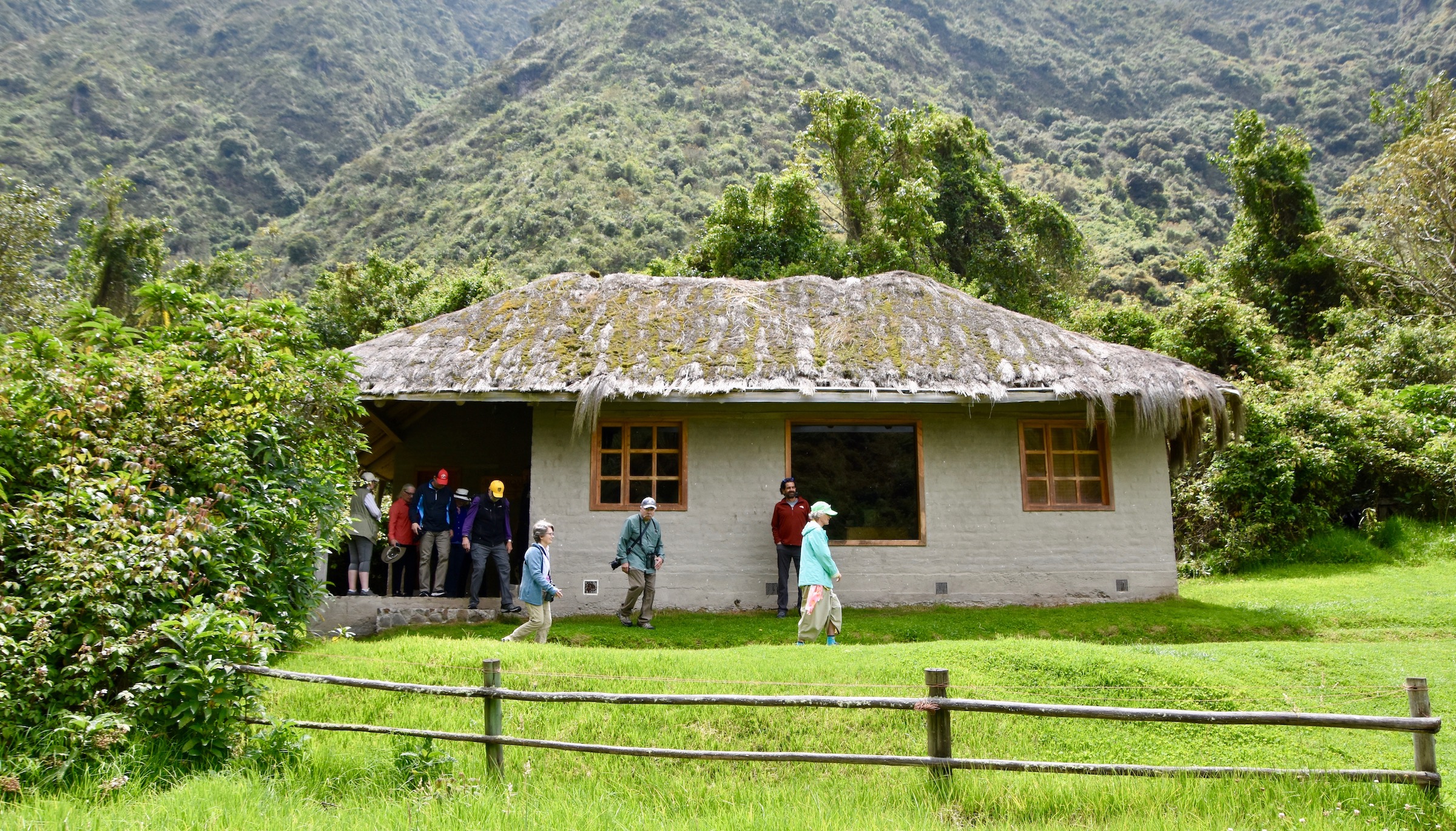
The Galo Plaza Lasso Foundation was founded in 1995 based upon the liberal principles of the former president for whom it is named. Those principles include conservation of Ecuadorean wildlife, creation of opportunities for Indigenous craftspeople and promotion of literacy through the Zuleta library (not the one in the hacienda, but a new building in the adjacent community). One of the missions is the Condor Huasi Project and we are headed there now. The road to the condors takes us past ranchland, the Caranqui mounds and deep into a lush valley that was once covered in glaciers, as hard as that it to believe today.
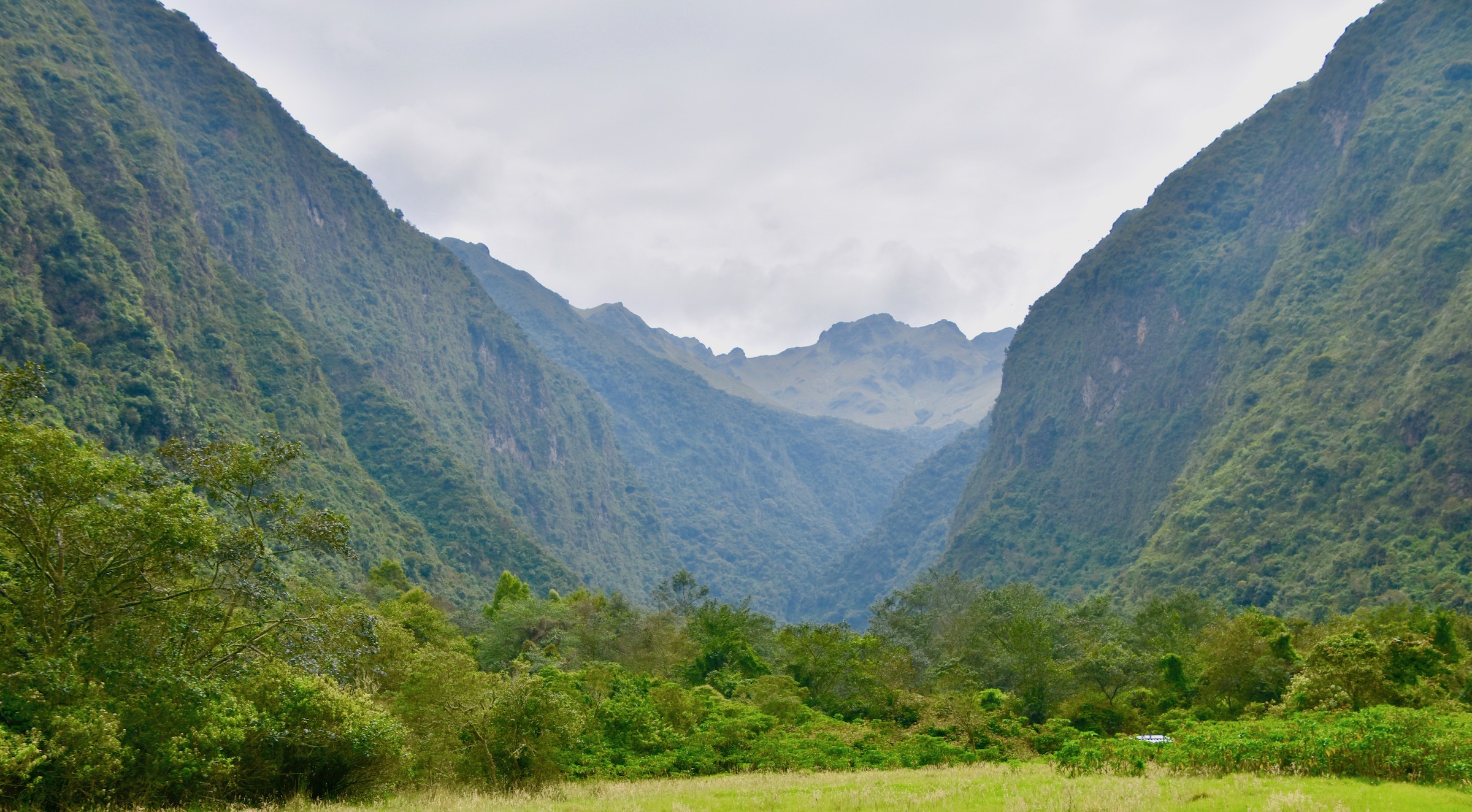
The road dead ends near a small brook and there are a number of options available from this point on including hiking a trail where you might find the rare and elusive spectacled bear, the only one native to South America.
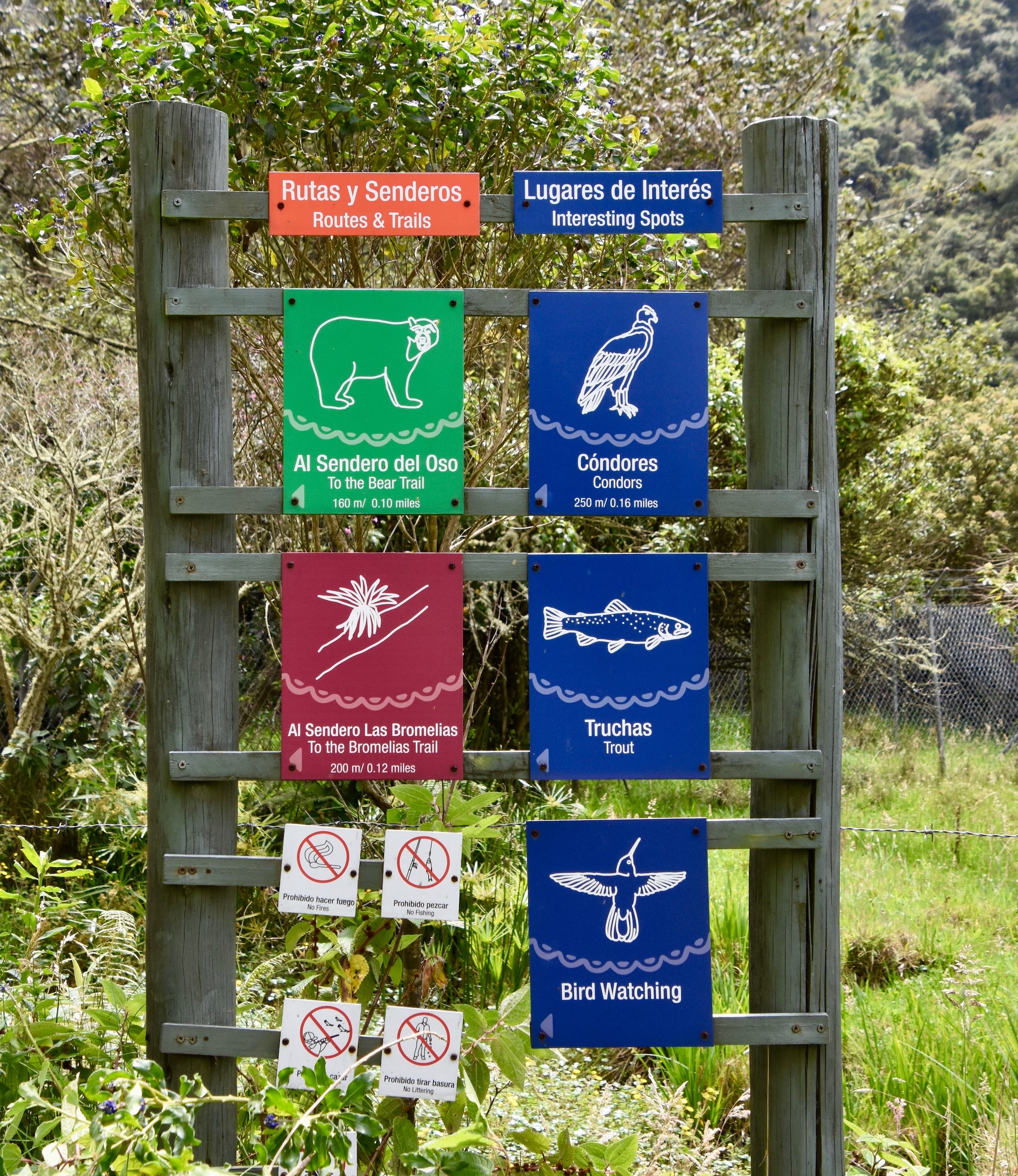
Alfredo leads us across the brook toward the Condor Huasi Project which is not far away across a field.
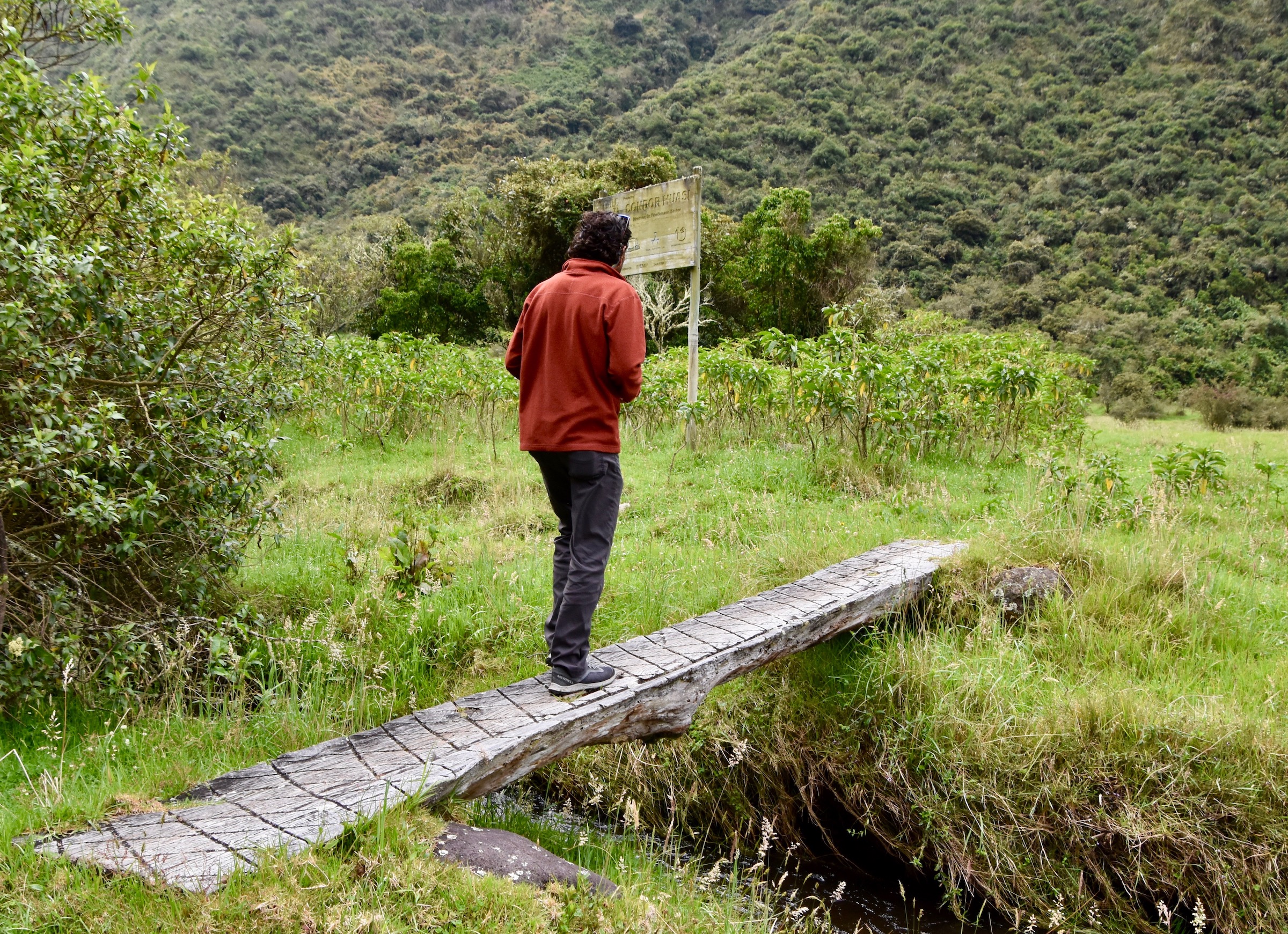
As we learned from our tour of Quito and in particular the Ecuadorean Independence Monument, the Andean condor is the national symbol of the country, much as the bald eagle is for United States. It is considered to be the largest bird of prey in the world and with a wingspan of over ten feet and a weight of over thirty pounds, the largest flying bird on earth. Fortunately for the smaller creatures of the Andes, it is primarily a scavenger and not an active predator. Similar to the fate of the bald eagle at one time, the Andean condor was persecuted by farmers who thought, mistakenly, that it preyed upon their livestock and often shot or poisoned condors. That combined with loss of habitat resulted in the Andean condor being placed on the Threatened Species list although its current status is ‘vulnerable’ which is at the less critical end of the spectrum. in terms of the species as a whole. However, in Ecuador it is considered to be critically endangered with only about 75 wild condors in the entire country.
Condors are very long-lived and take some time to reach sexual maturity. The Condor Huasi Project at Hacienda Zuleta serves two purposes – to rehabilitate injured wild condors and to breed new ones for release into the wild.
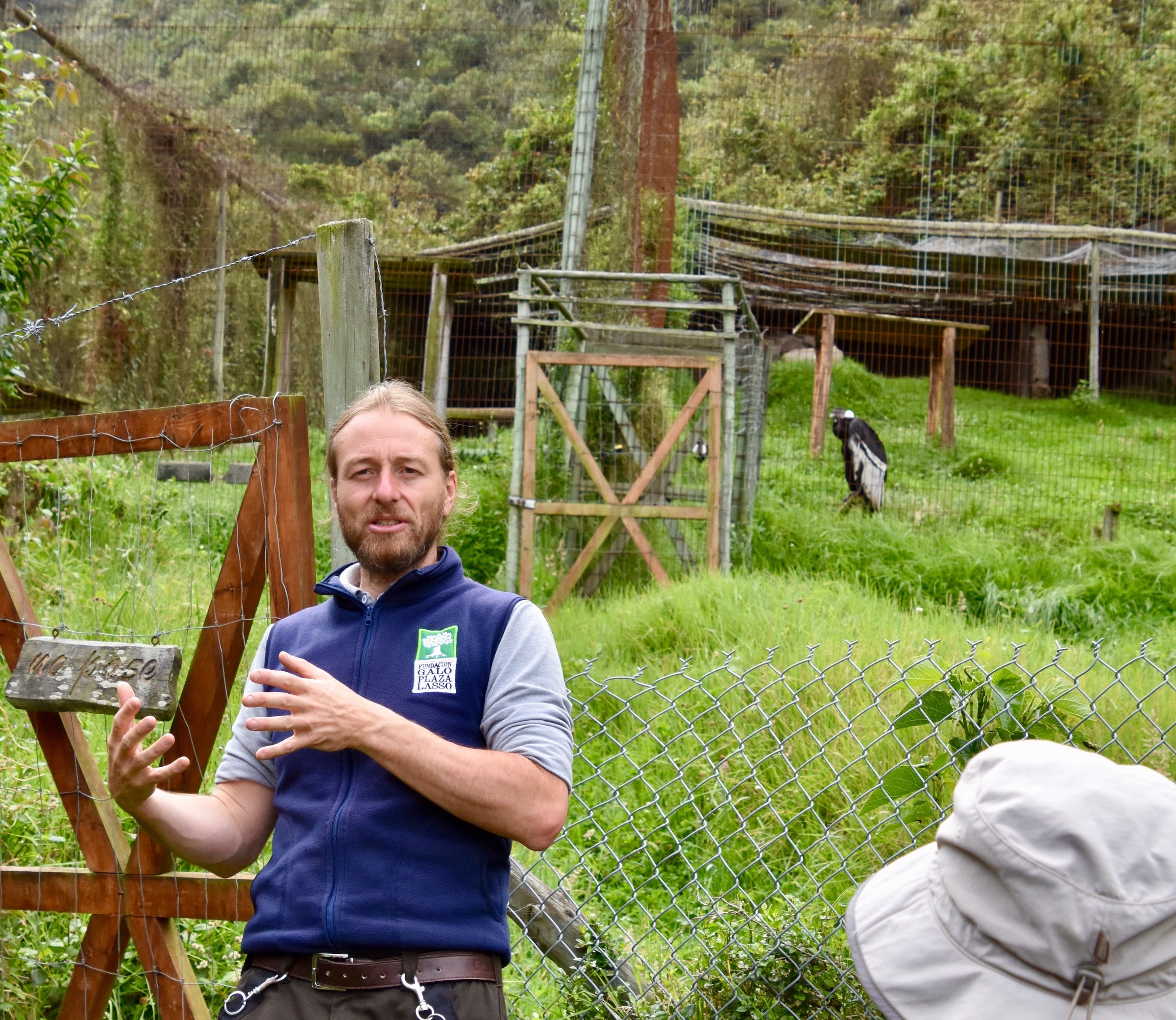
We are greeted at the outdoor compound by the Condor Huasi Project leader, Dr. Friedman Koster who gives us an explanation of why he is dedicating his life to saving the Andean condors in Ecuador. It’s certainly a noble cause and as we listen to him we can observe the condors in the compound behind him.
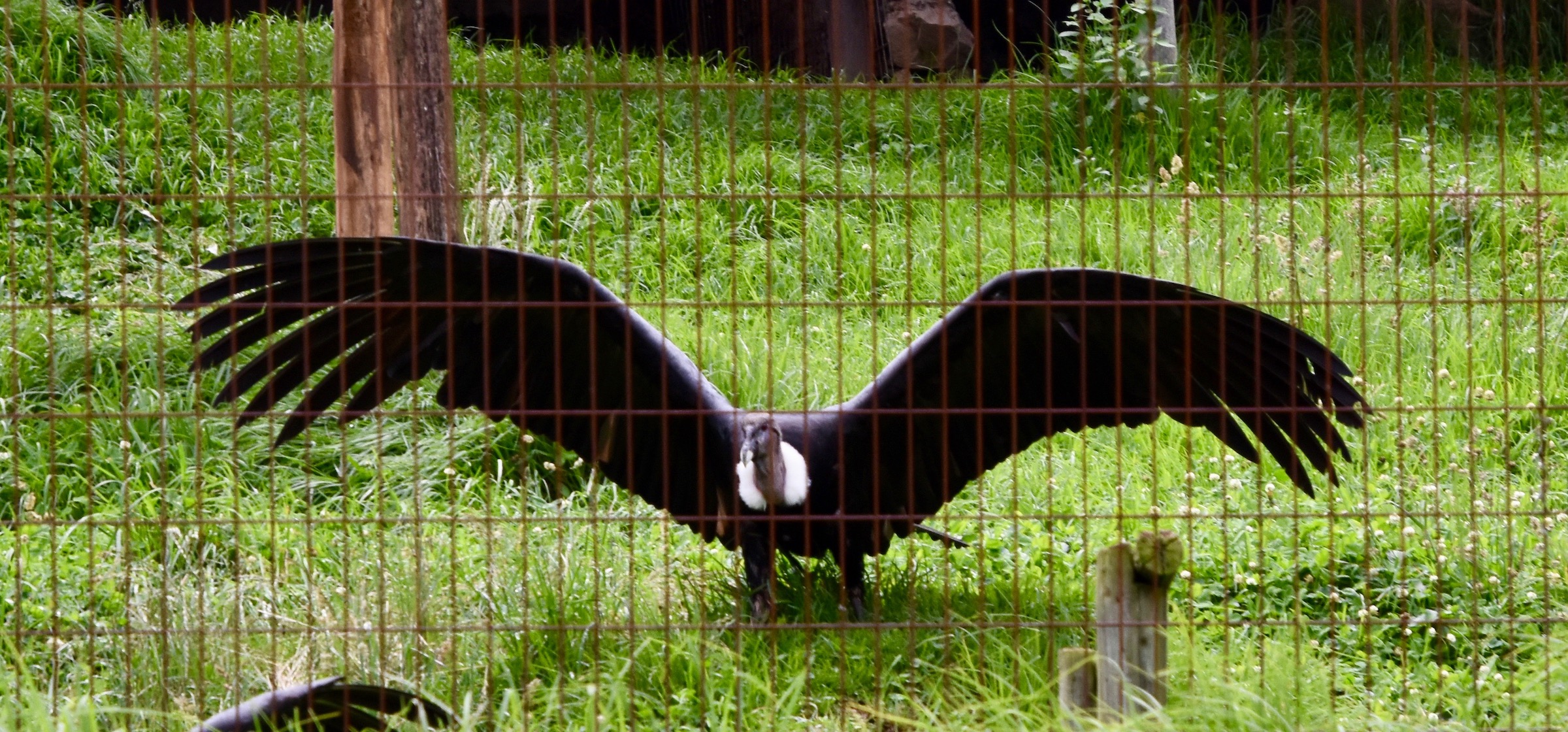
They are truly magnificent birds.
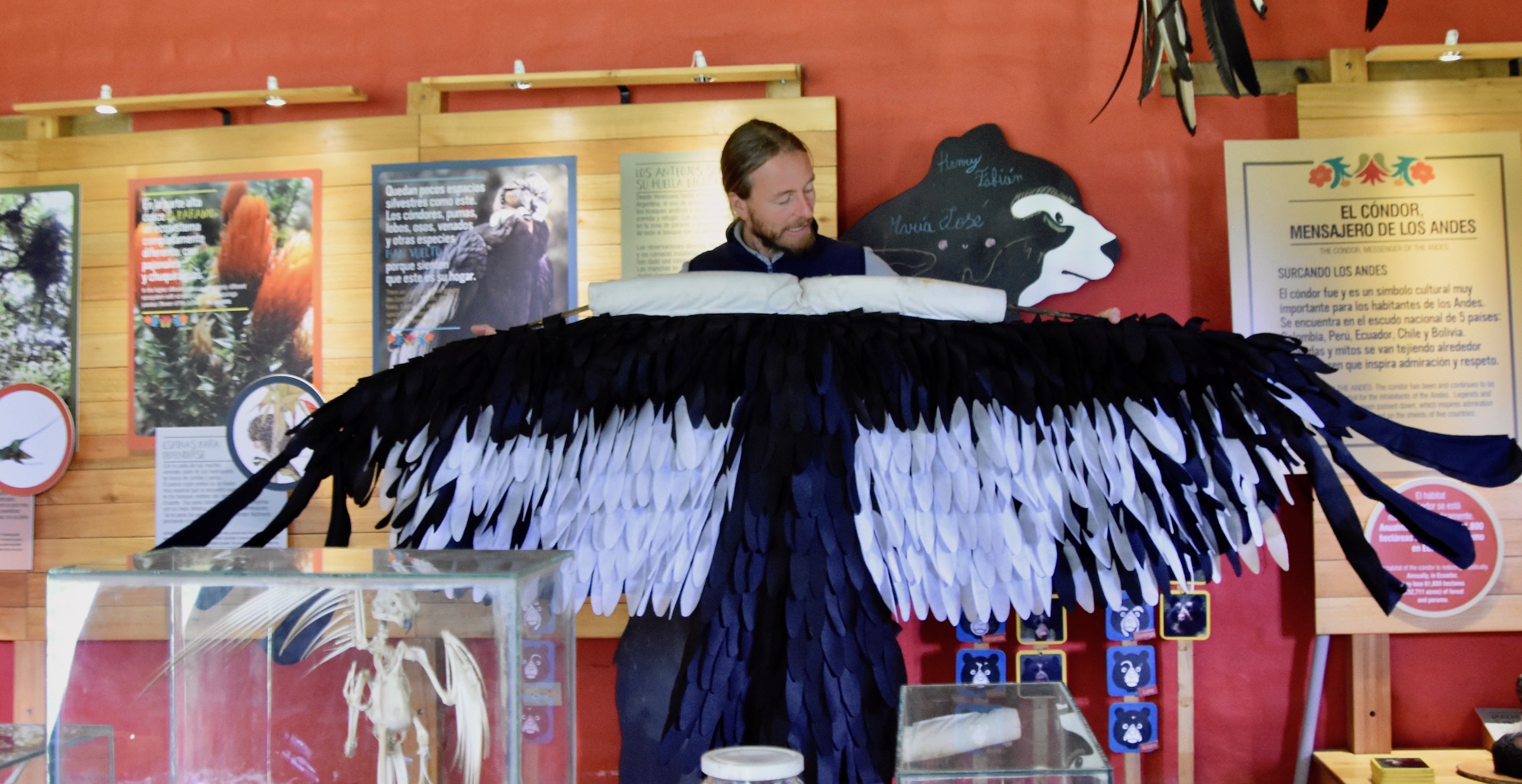
After everyone gets their photos of the condors, Dr. Koster leads us to the project’s small centre where he demonstrates the size of the Andean condors wingspan as well as providing information on spectacled bears and other species that inhabit the 4,000 acres of Hacienda Zuleta. He also explains that the presence of the condors at the Condor Huasi Project attracts wild condors who are often seen overhead. Sure enough as we head back outside two wild condors circle overhead. This is an incredible sighting for birders like me who could easily go a lifetime without seeing one in the wild. Please excuse the terrible photo, but I assure you those are Andean condors.
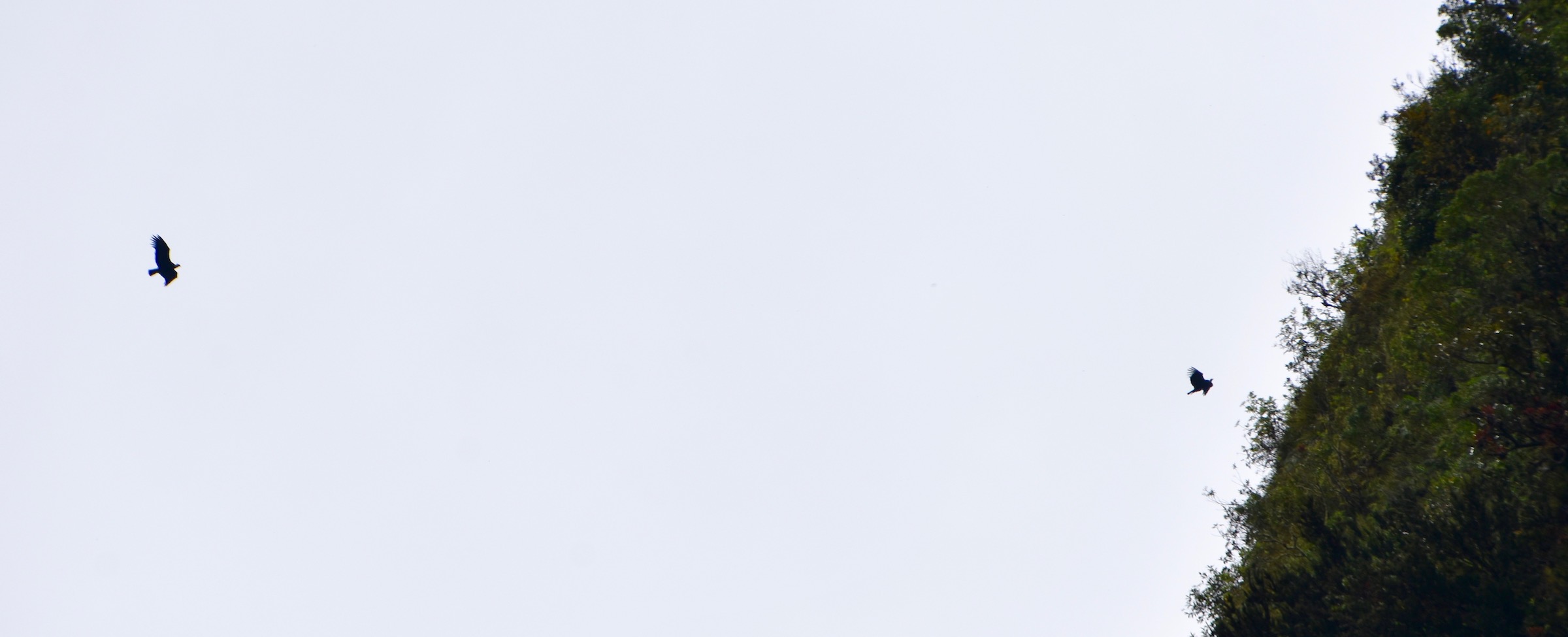
Way too soon it is time to leave Hacienda Zuleta and head back to Quito to begin the next part of our journey. Even though our time here was brief I am really grateful we came to this remarkable place and I will never feel guilty for watching Zorro again.
True to his word Alfredo has us stop at the equator on the way to Quito and we all get out photos taken on both sides of the hemisphere.
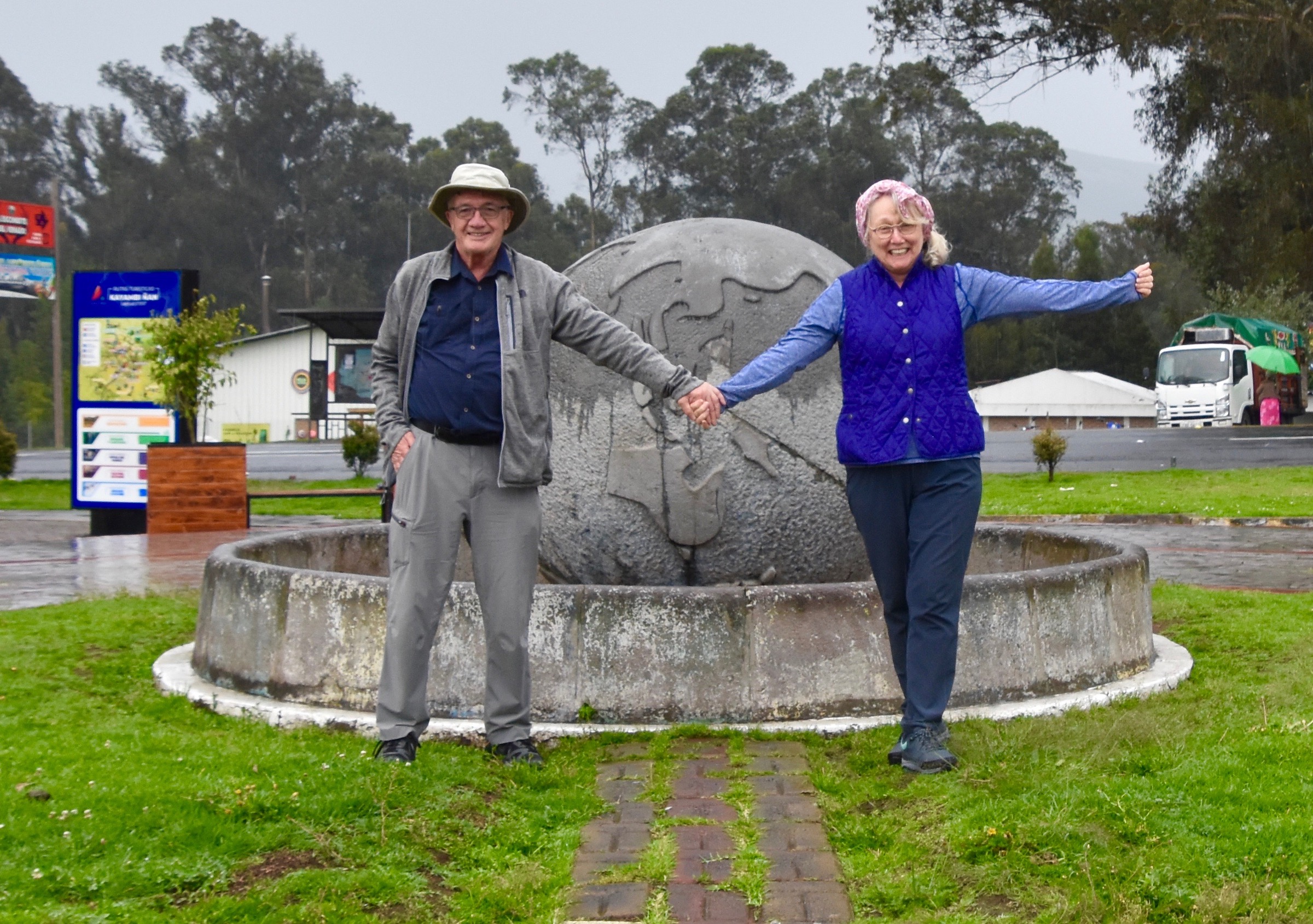
In the next post we’ll begin our journey to one of the most fabled spots on earth, the Galapagos Islands. I hope to see you there.

